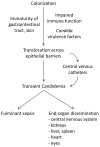The epidemiology and diagnosis of invasive candidiasis among premature infants
- PMID: 25677999
- PMCID: PMC4328135
- DOI: 10.1016/j.clp.2014.10.008
The epidemiology and diagnosis of invasive candidiasis among premature infants
Abstract
Invasive candidiasis is a leading infectious cause of morbidity and mortality in premature infants. Improved recognition of modifiable risk factors and antifungal prophylaxis has contributed to the recent decline in the incidence of this infection among infants. Invasive candidiasis typically occurs in the first 6 weeks of life and presents with nonspecific signs of sepsis. Definitive diagnosis relies on the growth of Candida in blood culture or cultures from other normally sterile sites, but this may identify fewer than half of cases. Improved diagnostics are needed to guide the initiation of antifungal therapy in premature infants.
Keywords: Candida; Neonatal candidiasis; Premature infants; Risk factors.
Copyright © 2015 Elsevier Inc. All rights reserved.
Conflict of interest statement
Dr. Benjamin receives support from the United States government for his work in pediatric and neonatal clinical pharmacology (1R01HD057956-05, 1K24HD058735-05, UL1TR001117, and NICHD contract HHSN275201000003I) and the nonprofit organization Thrasher Research Fund for his work in neonatal candidiasis (
Figures
References
-
- Saiman L, Ludington E, Pfaller M, Rangel-Frausto S, Wiblin RT, Dawson J, et al. Risk factors for candidemia in Neonatal Intensive Care Unit patients. The National Epidemiology of Mycosis Survey study group. The Pediatric infectious disease journal. 2000;19(4):319–24. - PubMed
-
- Cotten CM, McDonald S, Stoll B, Goldberg RN, Poole K, Benjamin DK., Jr The association of third-generation cephalosporin use and invasive candidiasis in extremely low birth-weight infants. Pediatrics. 2006;118(2):717–22. - PubMed
-
- Benjamin DK, Jr, DeLong ER, Steinbach WJ, Cotton CM, Walsh TJ, Clark RH. Empirical therapy for neonatal candidemia in very low birth weight infants. Pediatrics. 2003;112(3 Pt 1):543–7. - PubMed
-
- Friedman S, Richardson SE, Jacobs SE, O’Brien K. Systemic Candida infection in extremely low birth weight infants: short term morbidity and long term neurodevelopmental outcome. The Pediatric infectious disease journal. 2000;19(6):499–504. - PubMed
Publication types
MeSH terms
Substances
Grants and funding
LinkOut - more resources
Full Text Sources
Other Literature Sources


